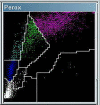Morphological anomalies of circulating blood cells in COVID-19
- PMID: 32279346
- PMCID: PMC7262044
- DOI: 10.1002/ajh.25824
Morphological anomalies of circulating blood cells in COVID-19
Figures


Comment in
-
The characteristic peripheral blood morphological features of hospitalized patients infected with COVID-19.Int J Lab Hematol. 2021 Jun;43(3):e130-e134. doi: 10.1111/ijlh.13417. Epub 2020 Dec 3. Int J Lab Hematol. 2021. PMID: 33270978 Free PMC article. No abstract available.
References
MeSH terms
Substances
LinkOut - more resources
Full Text Sources
Other Literature Sources
